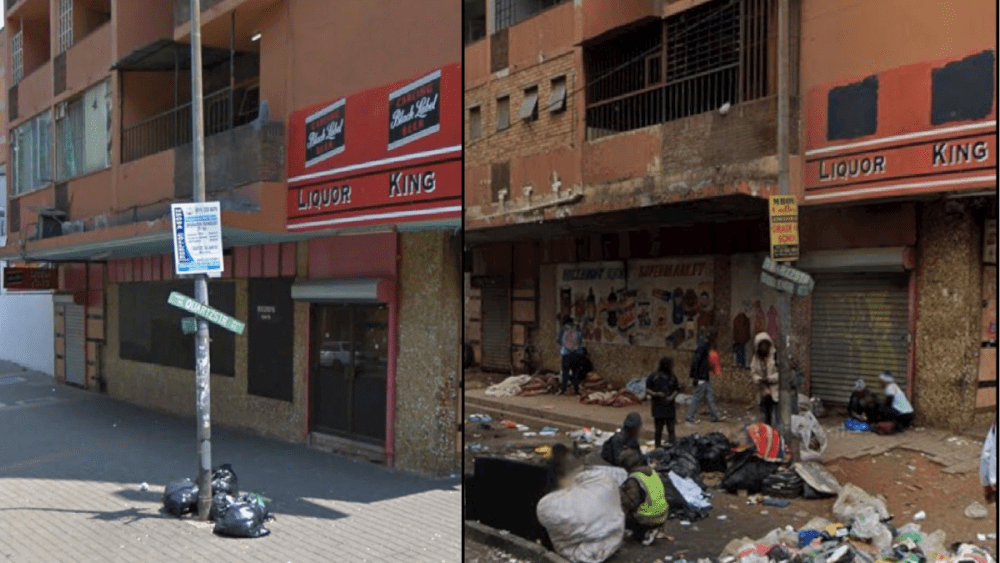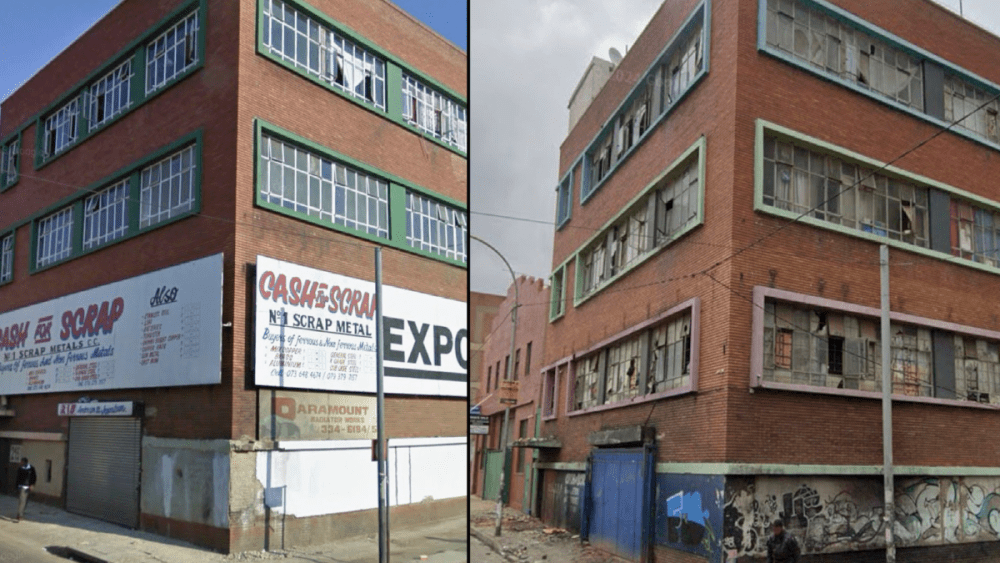The X account details the filth and decay with before and after photos. Here, the photo of the same building is shown in 2010, and again in 2023. (Photos supplied)
The City of Johannesburg has become notorious for decay, marked by crumbling infrastructure, derelict and neglected buildings, heaps of rubbish at every corner and knee-deep potholes.
The state of the city has deteriorated drastically over the past decade, with its decline now being documented on a social media account on X called “Jozi vs Jozi”.
The account was started at the end of September and has already garnered 33 700 followers. It juxtaposes photographs of landmarks, streets and buildings in Johannesburg from 10 to 15 years ago against more recent photos of the same areas, with the decay evident.
In one image, a face brick building on Anderson Street in 2009 stands firm on a clean pavement with its windows and window frames intact. The next photo is of the building as it stands today: stained with soot, cracked and vandalised windows, graffiti on walls and a neglected pavement, strewn with plastic bags.
The founder of the account spoke to the Mail & Guardian on condition of anonymity, saying he started the account “to remind people from Johannesburg what a semblance of normality looks like, because that’s something that they’ve forgotten about”.
“I think for me, Johannesburg, is a city that people have abused. South Africans have abused Johannesburg, because Joburg has given South Africans so much.
“It’s the only city in the country that you’ve seen economic mobility for poor black people, you see people who were previously marginalised, kind of enjoying a sense of, like ownership of capital businesses, and that’s the only place in South Africa you can see that. And people have just used Johannesburg as a place for extraction and not cared about the city, not appreciated it,” he said.
 A building in 2009, and again in 2023.
A building in 2009, and again in 2023.
Micheal Hart, an architect and urban designer who was involved in transforming urban structures into public spaces that could be accessed by all post-apartheid, told the M&G that the thought processes behind the urban renewal and transformation of the city “was cutting edge architectural and conservation theory” and was lost 10 years later to the “overarching desperation of the forgotten poor black, disillusioned and unwanted communities of urban outcasts”.
He added that the government’s failure to provide the right resources and services have left people destitute.
“The public spaces within our city are the living rooms of the homeless,” he said.
“Parks, streets, rivers, highway verges, under bridges, in stormwater drains, vacant buildings and any place that looks like shelter have become home to thousands of people.
“Our urban infrastructure has been eroded through vandalism and theft as human beings will do what it takes to gain a meal.”
The chairperson of the Johannesburg Heritage Foundation, David Fleminger, said that as a lifetime resident of Johannesburg, that although there are pockets of achievements and progress, the city has “bordered on hard times” and its decay has become very visible.
“There isn’t the right maintenance, there isn’t the appreciation of the heritage and of maintaining the heritage.
“It goes beyond heritage, really, because it goes down to roads, it goes down to storm drains, it goes down to even maintaining the roadsides, the litter is everywhere,” he said.
“These are all things that speak to a lack of effective management, and I think that that is really what’s deteriorating, is that over the past five to 10 years, there has just been a complete lack of management, and it’s not about which political party has control — the collective — the Johannesburg City Council has done a very poor job over the past five to 10 years, and they are the custodians.
“They are the ones who are responsible for maintaining the city, making sure that the city is kept in good condition, and we just haven’t seen this, especially in the last few years,” he added.
 Anderson Street in 2009, and again in 2023.
Anderson Street in 2009, and again in 2023.
The city has been marred with governance and leadership issues which saw five mayors being appointed in the last two years alone, the most recent being the ANC’s Dada Morero on 16 August who succeeded Al Jama-ah’s Kabelo Gwamanda.
The public’s response to the “Jozi vs Jozi” account has been shock, outrage and calls to the City of Johannesburg to take notice and intervene. The account holder said the responses indeed show that people do still care about the city.
The pictures are taken from Google street view, which the account holder said makes it objective, unmodified and open to the public, adding that his motivation to start this account came from a place of care but also heartbreak.
Other examples from the account show a comparison of Pretoria Street in Hillbrow, that in 2010 had smooth roads and well-kept businesses including Cash Converters, while the sight of tall buildings, still intact, are visible in the background. In 2023, the same road is dented with huge potholes, informal businesses are spilling into the street and the other shops appear to be torn down.
Themes of ruin, disrepair and erosion are displayed across the hundreds of posts, which also extend to areas like Randburg.
The city’s spokesperson, Nthatisi Modingoane, said many of these issues developed gradually and have been inherited by the new leadership, adding that urbanisation is adding pressure on the city’s resources.
“The rapid urbanisation of Johannesburg has placed immense pressure on its infrastructure and service delivery, resulting in various deficiencies.
“The city also faces additional challenges, including illegal dumping, vandalism, cable theft, littering, unauthorised structures and violations of by-laws,” he added.
But, said Modingoane, the city’s departments and entities are involved in ongoing maintenance and refurbishment projects across all seven regions of the city to address the problem. Citizens were also encouraged to report pothole defects to the Johannesburg Roads Agency, which has been conducting routine inspections.
To deal with the issue of litter, Pikitup is sending human and fleet resources daily to collect waste and clean streets, as well as to clear illegal dumping hotspots and increasing litter-picking and street-sweeping operations in densely populated areas such as the inner city.
Fleminger said Johannesburg had symbolised opportunity and upward mobility, but today, it symbolises a city that has been neglected. But, he said, there is still hope and potential in the city and there are civic organisations that want to reverse the decay.
“It’s not too late. We can turn Johannesburg around, but it is going to take a good effort, and it is going to take a change in attitude from the civic authorities to realise that they cannot do this by themselves.”
Jozi vs Jozi’s founder said people have to reimagine Johannesburg in the 21st century.
“People that are saying, let’s take Johannesburg back to the 1980s, [need to realise] that’s never going to happen, because that city that we are nostalgic about wasn’t dealing with crippling levels of migration into the city from all parts of the country and Africa. It wasn’t dealing with social economic inequality and unemployment. Those cities of the past don’t have to deal with these kinds of issues.”
He said people need to think about what kind of city they would like to see with all these issues.
“What do we see in the 21st century: a modern, functional African city, where everybody from walks of life can feel comfortable and can experience mobility.”